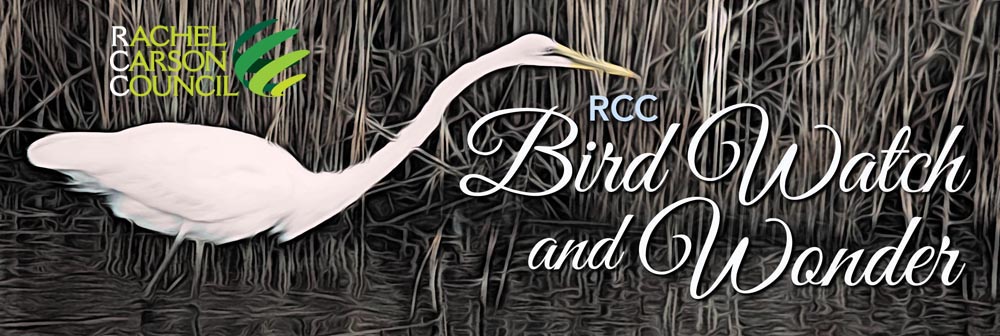 | | | "What if I had never seen this before? What if I knew I would never see it again?”― Rachel Carson, The Sense of Wonder It is now the dead of winter. And a frigid one at that. Not the best time for a leisurely bird walk. But February has also brought us the deadly, frigid hearts of the Trump-Musk regime that has been rolling back our democracy and any protections they can for humans, birds, and wildlife. It is a death knell for many of those things we have held most dear. It is essential, then, that we cherish all that we still have and find some respite and relief from the assaults that surround us. And, most importantly, that we turn our attention to what we can do to celebrate, observe, preserve and protect the beauty, joy, and wonder of nature and the people it surrounds. 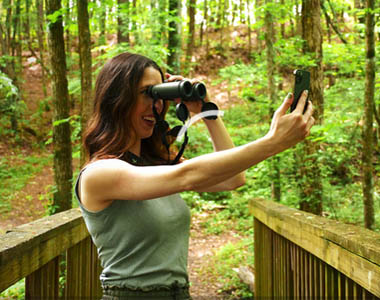 That is why in this February, 2025 issue of the RCC’s Bird Watch and Wonder, we open with the happy news that you and I are not alone. The U.S. Fish and Wildlife Service (USFWS) has found that there are now about 100,000,000 Americans who look at and look after birds. That is far more than the number of gun owners in the U.S., as I wrote a couple of years ago in “Birds or Guns” when birdwatchers were just about to pass those who own guns. And, all of you bird watchers and nature lovers are taking action. In Ohio, for instance, climate change means that migrating birds returning north are finding fewer food sources when they arrive. Urged on by cleveland.com and writer, Lois Rose, Ohioans are now planting their yards with bird-friendly shrubs, bushes and trees, and putting out various foods for the migrants when they arrive. That is why in this February, 2025 issue of the RCC’s Bird Watch and Wonder, we open with the happy news that you and I are not alone. The U.S. Fish and Wildlife Service (USFWS) has found that there are now about 100,000,000 Americans who look at and look after birds. That is far more than the number of gun owners in the U.S., as I wrote a couple of years ago in “Birds or Guns” when birdwatchers were just about to pass those who own guns. And, all of you bird watchers and nature lovers are taking action. In Ohio, for instance, climate change means that migrating birds returning north are finding fewer food sources when they arrive. Urged on by cleveland.com and writer, Lois Rose, Ohioans are now planting their yards with bird-friendly shrubs, bushes and trees, and putting out various foods for the migrants when they arrive. 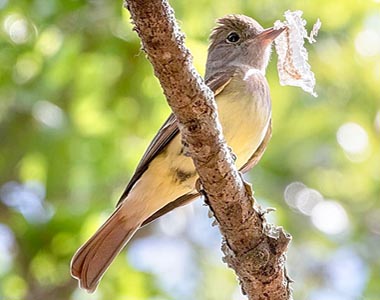 Part of our concern for birds comes not only from their songs and beauty, but also their amazing behavior and intelligence. In our section on “Birds, Climate, and Ecology” you’ll find that one of my favorite birds, the Great Crested Flycatcher, like other cavity-nesters, lines its nest with shed snake skins that help scare off predators. Part of our concern for birds comes not only from their songs and beauty, but also their amazing behavior and intelligence. In our section on “Birds, Climate, and Ecology” you’ll find that one of my favorite birds, the Great Crested Flycatcher, like other cavity-nesters, lines its nest with shed snake skins that help scare off predators.
 Our fascination with birds has long predated our times and persisted in cultures and eras of all sorts. In “Bird Lore,” Paul Opodaca talks about the importance and meaning of birds in Indigenous cultures, including members of Native American Cahuilla tribes who sing Cahuilla bird songs, a tradition that continues today. Our fascination with birds has long predated our times and persisted in cultures and eras of all sorts. In “Bird Lore,” Paul Opodaca talks about the importance and meaning of birds in Indigenous cultures, including members of Native American Cahuilla tribes who sing Cahuilla bird songs, a tradition that continues today.
Birds have not only fascinated humans throughout history, but also improved our lives, as Jim Robbins reveals in The Wonder of Birds: What They Tell Us About Ourselves, the World, and a Better Future in this month’s “Books” section. Then, wonder at and learn from our feathered friends in “The Best of Bird of the Week” and “The Best of Momentary Mediations.” 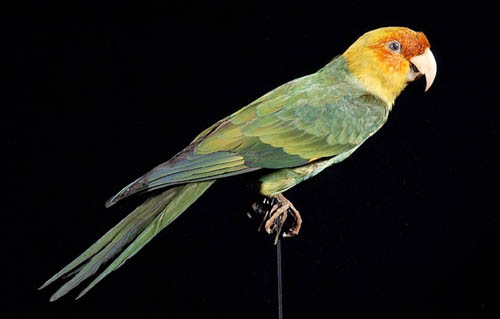 But what if we knew that we might never see them again? Our usually witty bird meister, Ross Feldner, has pondered that reality. Birds of all kinds and their habitats have been diminishing for decades now (though some are actually increasing). That trend is likely to accelerate over the next four years. But it is not inevitable. Feldner invites us to revisit and mourn remarkable bird species like the Carolina Parakeet or the Passenger Pigeon that have become extinct in the United States as a result of cupidity and callousness. His remarkable reminiscence of and fondness for the birds we have lost is meant not to have us retreat to despair. It is meant rather to celebrate the wonders of the billions of birds that we do have and take action to protect them and their homes – homes that they, in fact, share along with us. But what if we knew that we might never see them again? Our usually witty bird meister, Ross Feldner, has pondered that reality. Birds of all kinds and their habitats have been diminishing for decades now (though some are actually increasing). That trend is likely to accelerate over the next four years. But it is not inevitable. Feldner invites us to revisit and mourn remarkable bird species like the Carolina Parakeet or the Passenger Pigeon that have become extinct in the United States as a result of cupidity and callousness. His remarkable reminiscence of and fondness for the birds we have lost is meant not to have us retreat to despair. It is meant rather to celebrate the wonders of the billions of birds that we do have and take action to protect them and their homes – homes that they, in fact, share along with us. | | | | | | | | 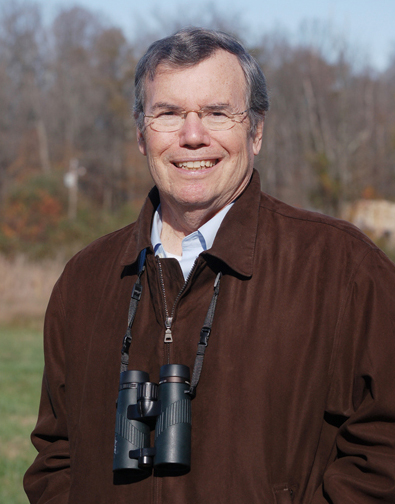 Bob Musil is the President & CEO of the Rachel Carson Council and author of Rachel Carson and Her Sisters: Extraordinary Women Who Have Shaped America’s Environment (Rutgers, 2016) and Washington in Spring: A Nature Journal for a Changing Capital (Bartleby, 2016). He is also the editor of the forthcoming annotated edition from Rutgers University Press of Rachel Carson’s Under the Sea-Wind with his Introduction, updated marine science, and historic and contemporary illustrations and photographs. Bob Musil is the President & CEO of the Rachel Carson Council and author of Rachel Carson and Her Sisters: Extraordinary Women Who Have Shaped America’s Environment (Rutgers, 2016) and Washington in Spring: A Nature Journal for a Changing Capital (Bartleby, 2016). He is also the editor of the forthcoming annotated edition from Rutgers University Press of Rachel Carson’s Under the Sea-Wind with his Introduction, updated marine science, and historic and contemporary illustrations and photographs. | | | | | | What Bird is That? How You Can Easily Identify A Bird You See in the Wild. One of the simplest ways to slow down is to stop, smell the roses and listen to the birds. However, it seems people are starting to do more than just listen to them. The hobby of bird watching might be more popular than you think. A December 2024 article from the U.S. Fish & Wildlife Service revealed that 96 million Americans turned their eyes to the skies in 2022 to seek out our feathered friends. | | | | | | | | Long Overlooked and Understudied, the Fish Crow Is Worth Your Attention If you haven’t given these corvids much thought, you’re not alone—but you’re also missing out. What bird is more familiar than the crow? Across nearly the entire continental United States the clever and sociable corvids are ubiquitous, and they reward the close observer with their antics. But whether you’re a newly appreciative corvid-watcher or a longtime crow fan, you might be surprised to learn that all along you’ve been admiring not one but two different species. | | | | | | | | Bird Watchers Are Traveling to Kansas For a Look at This 'mega-rarity' Bird watchers are flocking to southwest Kansas after the appearance there of a Ross's gull, a rare species generally found only in Siberia, Greenland, Canada and northern Alaska. "This is a really big deal to birders, not only to Kansans but to birders across the United States," said Carol Morgan, president of the Topeka Audubon Society. | | | | | | | | Maryland’s 2025 Midwinter Waterfowl Survey Shows Higher Bird Counts Aerial survey teams of pilots and biologists from the Maryland Department of Natural Resources and U.S. Fish and Wildlife Service have completed their annual population estimates of ducks, geese, and swans along the state’s Chesapeake Bay, tidal Potomac River and Atlantic coast shorelines. This year, the teams counted about 705,300 waterfowl, which was higher than both the 593,200 birds observed in 2024 and the most recent five-year average of 624,300 birds. | | | | | | | | Climate Change Can Mean Fewer Birds in Our Northeast Ohio Yards. Here’s How to Help. If you are an avid birdwatcher or even a casual observer, you are probably aware that there are fewer birds in our yards and parks now than before. One reason for this is climate change, which can cause a mismatch between birds and their foods. Most insect-eating birds in northeast Ohio migrate south during the fall because they can’t survive on insects during the winter. Their return is triggered by day length; temperature has nothing to do with it. | | | | | | | | Bird Deaths Plummet at McCormick Place Lakeside Center After Safety Film Installed For more than 40 years, migrating birds have been crashing into McCormick Place Lakeside Center. The glassy, low-lying convention building on the shores of Lake Michigan has been the scene of about 1,000 deadly collisions per year, according to Dave Willard, retired Field Museum bird division collections manager. In 2023, the death toll for a single day was so high — at least 960 birds — that the carnage became national news. | | | | | | | | Vital Helicopters Honored in Efforts to Save Native Kauai Birds Dozens gathered for a blessing to mark the start of the forest bird season at Lihue’s airport on Monday. This year’s annual field season blessing recognized the important role helicopters have in the fight to save Kauai’s forest birds. This year, helicopters will transport the researchers and their supplies, so they avoid hiking on foot to various locations which can take several hours away from crucial fieldwork with the birds. | | | | | | | | BirdScapes Are Key to Helping Migratory Birds Recover The great streams of migratory birds that once filled North America's skies are dwindling as habitat loss, climate change, and other threats take their toll. The declines cast doubt on the continued survival of these birds and the greatest wildlife phenomenon in the West. Confronting these threats, and bringing back the birds, requires innovation on a grand scale. That's the thinking behind our new BirdScapes approach, which builds on our 25+ years of experience with migratory bird conservation. | | | | | | | | Gone But Not Forgotten “The story of its passing is a shameful record of human cruelty, avarice and indifference – a story one wishes had never been told." – W.E. Clyde Todd The extinction of the Passenger Pigeon, once numbering in the billions, is the best known. But is not the only story of decline and extinction among American birds. Extinction: in biology, the dying out or extermination of a species. | | | | | | | | Cavity-nesting Birds Cleverly Use Snake Skin to Protect Their Young From Predators When a bird drapes its nest with snake skin, it isn't just making an interesting home décor choice. For some birds, it keeps predators at bay. Researchers combined new and historical data to show birds that nest in cavities—covered nests with small openings—are more likely to use shed snake skins in their construction than birds that build open-cup nests, and this practice helps deter predators from eating the eggs. | | | | | | | | Fix Our Forests Act Advances in Congress, Spotlighting the Growing Wildfire Risk to Forests and Communities, But Further Improvements Needed Wildfire is a growing risk and every year it consumes millions of acres of forests and grasslands, devastating communities, local businesses, and the natural resources that wildlife and people depend on. Last week, the U.S. House of Representatives passed the Fix Our Forests Act (H.R. 471), introduced by Rep. Bruce Westerman (R-AR) and Rep. Scott Peters (D-CA). | | | | | | | | Experts Reveal Why So Many Dead Birds Are Washing Up on Lake Michigan's Shore According to the Illinois Department of Natural Resources, conservation officers received reports over the weekend of "ducks, red-breasted mergansers, and Canada geese washing ashore Over the weekend and early Monday morning, a large number of dead birds were seen washed up on numerous beaches along Lake Michigan in Chicago. | | | | | | | | | | Here’s How the Los Angeles Wildfires Are Affecting Animals, From Fish to Snakes to Birds While scientists were able to save and move some creatures in the aftermath, researchers are worried about the prospects for other species, On January 23, dozens of biologists laden with electrified backpacks, nets and buckets marched into the smoldering moonscape that the Palisades Fire had created in the Santa Monica Mountains. A rescue mission was afoot, with no time to waste—rain was coming. | | | | | | | | Birds Shifting More in Time Than Space as They Adjust to Global Warming As North America heats up due to climate change, animals are responding in three primary ways: moving north, heading to higher elevations and making phenological changes — adjusting annual cycles such as when they breed. A new UCLA study analyzed 27 years of data across 311 land-based species to examine how North American birds have responded simultaneously using all three methods. | | | | | | | | Birds Co-mingle Our Aesthetics and Our Science Birds are often associated with themes of renewal and rebirth symbolizing the cyclical nature of life. For centuries, and most notably in Renaissance art, birds represented resurrection of the soul. In Mexican art, and based on an Aztec prophecy, the flag features an Eagle devouring a snake from a cactus plant. Peacocks are a common motif in Persian art symbolizing eternal life. There is no shortage of depictions of birds over as many cultures. | | | | | | | | Rare Collection of Bird Illustrations to Go on Display at Houston Museum of Natural Science A new exhibition featuring a rare collection of prints is coming to the Houston Museum of Natural Science next month. The Audubon's Birds of America exhibition will feature 46 prints from Nation Museums Scotland's collection. Birds of America is a series that was published from 1827 to 1838 in which John James Audubon attempted to paint every bird species in North America. | | | | | | | | Avian Archetypes: Native American Folklore’s Most Fascinating Birds As a doctoral candidate in folklore and mythology at UCLA in the 1990s, Paul Apodaca focused his dissertation on the Cahuilla bird songs, a tradition that continues today among members of Native American Cahuilla tribes. The recipient of the award for Outstanding Graduate Student of the Year, he even invited modern-day bird singers to campus at UCLA’s annual Pow Wow. Despite the name, he explains, the songs are not about birds at all. | | | | | | | | Florida Might Be Getting a New State Bird A lawmaker in Florida has filed a bill to make the flamingo the official state bird. The mockingbird has been Florida's state bird since 1927, when the state was much more agricultural and less populated on the coasts. The proposed change highlights the state's modern identity and the conservation efforts that have facilitated a resurgence of flamingos in Florida following the bird's near disappearance from the state in the early 20th century. | | | | | | | | The Birds’ Guide to Surviving Winter Their feathers, roosting behaviors and adaptability help birds survive the cold, “nature’s proving ground.” Winter mornings begin at David Sibley’s Deerfield, Mass., household as they do at my similarly rural place 90-something miles to the west and south, across the New York line: with filling the bird feeders. “Baby, it’s cold outside” takes on a new meaning when many in your customer base weigh barely as much as a few pieces of pocket change. | | | | | | | | On a Cold, Dark Inauguration Day, a Message From the Birds Just before dark on New Year’s Eve, I filled all the bird feeders, and I didn’t skimp on the good stuff: black nyjer thistle for the finches, two kinds of suet for the woodpeckers, whole peanuts for the crows and the blue jays, a high-protein woodland mix dense with shelled peanuts and sunflower hearts for everybody. The birds would wake to a New Year’s feast. I thought of it as the avian equivalent of the black-eyed peas and greens that the humans in the house would be eating for good luck later in the day. In 2025 we will be needing all the luck we can get. | | | | | | | | American Avocet - Ross Feldner This elegant, leggy wader moves through shallow waters swishing its thin, upturned bill from side to side looking to catch aquatic invertebrates. American Avocets were previously found across most of the United States until extirpated from breeding on the East Coast. Their breeding habitat consists of marshes, beaches, prairie ponds, and shallow lakes in the mid-west. Their migration route lands them in almost every state in the western United States and on the East Coast from Delaware south to Florida where they spend the winter. | | | | | | | | Momentary Meditations are published every Monday to awaken what Rachel Carson called “the sense of wonder” and what Albert Schweitzer called “a reverence for life.” Looking deeply into our interdependence with all life on earth helps us know what we must do. In our harried world, these meditations are meant to serve as a renewable resource for compassion and love. Snow Hawk – Stephen Shick A soft snow was gently falling as this hawk and I exchanged mindful glances. For a moment, we felt safe together in a changing world. | | | | | | | | Enjoy Birdwatching By Going to Festivals A great way to enjoy birdwatching is by going to festivals—they’re organized to get you to well-known birding spots at the right time of year, and they’re a perfect way to meet people. Experts and locals help you see more birds, and you’ll meet other visitors who share your hobby. While you’re there, keep an eye out for Cornell Lab representatives, as we do attend several festivals each year. | | | | | | | | The Wonder of Birds: What They Tell Us About Ourselves,
the World, and a Better Future 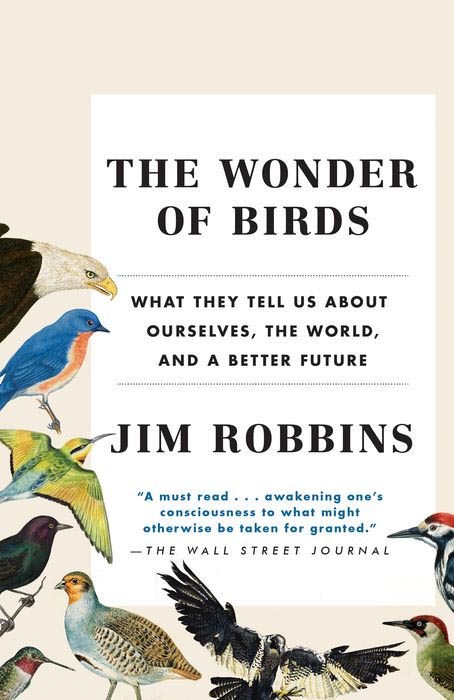 A fascinating investigation into the miraculous world of birds and the powerful—and surprising—ways they enrich our lives and sustain the planet. A fascinating investigation into the miraculous world of birds and the powerful—and surprising—ways they enrich our lives and sustain the planet.
Our relationship to birds is different from our relationship to any other wild creatures. They are found virtually everywhere and we love to watch them, listen to them, keep them as pets, wear their feathers, even converse with them. Birds, Jim Robbins posits, are our most vital connection to nature. They compel us to look to the skies, both literally and metaphorically; draw us out into nature to seek their beauty; and let us experience vicariously what it is like to be weightless. Birds have helped us in so many of our human endeavors: learning to fly, providing clothing and food, and helping us better understand the human brain and body. And they even have much to teach us about being human in the natural world.
“Engaging, thoughtful . . . worthy of a place alongside David Attenborough’s documentary The Life of Birds or Graeme Gibson’s The Bedside Book of Birds . . . This offering will appeal to naturalists, anthropologists, linguists, and even philosophers as well as to lay readers.”—Library Journal Click here to purchase | | | | | | | | | | Ornithography An Illustrated Guide to Bird Lore & Symbolism By Jessica Roux  From the creator of Floriography and the Woodland Wardens Oracle Deck comes this beautifully illustrated exploration of the folklore, mythology, and history surrounding our favorite winged companions. From the creator of Floriography and the Woodland Wardens Oracle Deck comes this beautifully illustrated exploration of the folklore, mythology, and history surrounding our favorite winged companions.
Birds have inspired us since the dawn of time: their elegance in flight, captivating colors, and delicate mannerisms spark hope, joy, and delight. Cultures around the world have historically looked to birds as sacred messengers, intermediaries between earth and sky, including them in myths and legends and using them to teach moral lessons and historical truths.
In Jessica Roux’s Ornithography, each of 100 entries focuses on one bird species, featuring a full-page color illustration in her detailed, darkly romantic style and the lore behind each bird. The perfect gift for birdwatchers, gardeners, and history buffs, as well as all readers who appreciate nature, mythology, and art, Ornithography is as intriguing and playful as the feathered muses that fill its pages. Click here to purchase | | | | | | The Crimson Wing: Mystery of the Flamingos 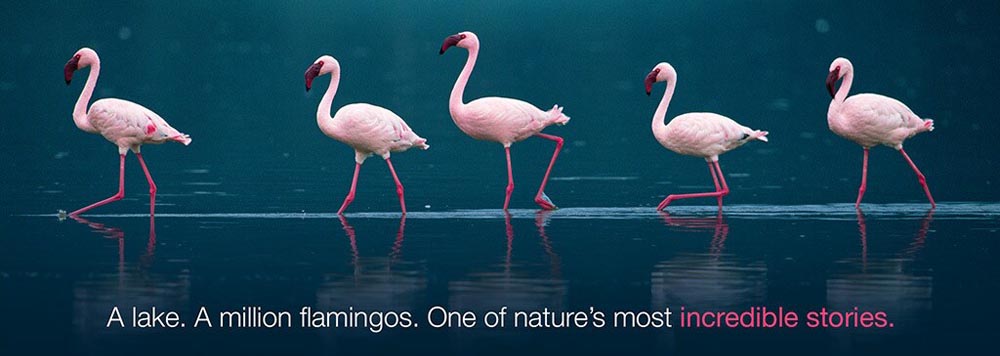 Discover one of nature's last great mysteries in The Crimson Wing, a miraculous story of love, courage and survival from Disneynature, the studio that brought you EARTH. In a place like no other on the planet, the dramatic and desolate Lake Natron in northern Tanzania, you'll witness a spectacle unlike anything you've seen before: a million crimson-winged flamingos arrive to continue the circle of life. Focusing on the adventures of a single chick set against a backdrop of never-before-filmed landscapes, The Crimson Wing is a visually stunning journey into the life and struggles of the mysterious and inspiring flamingo. Click here to stream. Discover one of nature's last great mysteries in The Crimson Wing, a miraculous story of love, courage and survival from Disneynature, the studio that brought you EARTH. In a place like no other on the planet, the dramatic and desolate Lake Natron in northern Tanzania, you'll witness a spectacle unlike anything you've seen before: a million crimson-winged flamingos arrive to continue the circle of life. Focusing on the adventures of a single chick set against a backdrop of never-before-filmed landscapes, The Crimson Wing is a visually stunning journey into the life and struggles of the mysterious and inspiring flamingo. Click here to stream. | | | | The February 2025 issue of Bird Watch and Wonder was produced by Ross Feldner | | | |  The Rachel Carson Council Depends on Tax-deductible Gifts From Concerned Individuals Like You. Please Help If You can. The Rachel Carson Council Depends on Tax-deductible Gifts From Concerned Individuals Like You. Please Help If You can. | | | |  Sign Up Here to Receive the RCC E-News and Other RCC Newsletters, Information and Alerts. Sign Up Here to Receive the RCC E-News and Other RCC Newsletters, Information and Alerts. | | | | | | | | | | | |